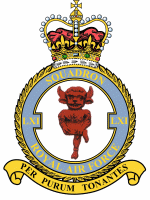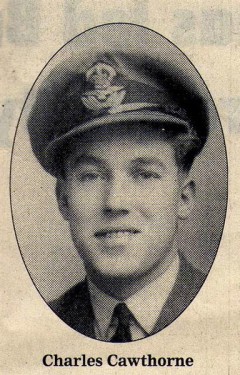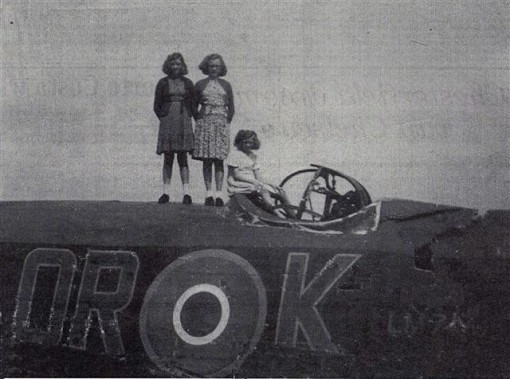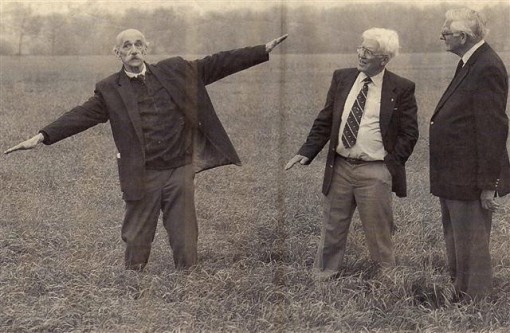Wing Commander Charles Cawthorne DFC - POW
Volunteered for the Royal Artillery, but transferred to RAF pilot training on first leave
Wing Commander Charles Cawthorne DFC.
He joined the RAF as a boy apprentice, enlisting on the,5th September 1939, during training he applied for pilot training but was never called upon. The three year apprenticeship was reduced to two years due to demand for tradesmen but eventually at the age of eighteen he was accepted for aircrew training and sent to St Athans for training as an air engineer firstly on Stirlings then on to Lancs.
His first flight experience on joining No 467 RAAF Squadron was to fly the Manchester, the two engined Lanc. He successfully negotiated the task of flying a heavy bomber by achieving 16 hours on Manchesters, and very scary too. There followed further training on Lancasters and at the tender age of 18 years started his tour of operations. In early 1943 most of his targets were in the dreaded Ruhr Valley with numerous trips to Italy and deep distant targets in Germany, Chechoslovakia. Republic and one raid involving
landing in N Africa.
He recalls:
"On August 17 1943 I took part in a low level full moon raid on Penemunde, the rocket research establishment sited on the Baltic coast. On leaving the target we were attacked by a night fighter and sustained severe damage resulting in the rear gunner receiving a serious shell wound to his foot and the creation of a serious fire within the fuselage where hydraulic oil from a ruptured pipe to the rear turret sprayed oil within the rear fuselage. The rear turret and ammo boxes and supply trays to the rear turret were burning furiously, I reported the situation to the Aussie pilot who simply told me to go and put the bloody fire out. Fortunately the mid-upper gunner had shot down the fighter he joined me and the WOP in fighting the fire with extinquishers and gloved hands.
It remained for the rear gunner to be chopped out of his severely damaged turret and laid on the rest bed. I attempted to inject morphine into his smashed leg and while cutting away his blood soaked flying boots, inadvertantly cut part of his skin.
We had lost an appreciable amount of fuel, a quick calculation resulted in making an immediate diversion to Sweden. Recalculation of fuel reserves enabled us to re-route to our UK base. As the trim tabs had been shot away, control difficulties were experienced. With the aircraft constantly reverting to a climb the pilot and I removed our Mae Wests, inflated them and stuffed them between penetration raids to Fortunately the mid-upper gunner had shot down the fighter he joined me and the WOP in fighting the fire with extinquishers and gloved hands. It remained for the rear gunner to be chopped out of his severely damaged turret and laid on the rest bed. I attempted to inject morphine into his smashed leg and while cutting away his blood soaked flying boots, inadvertantly cut part of his skin. We had lost an appreciable amount of fuel, a quick calculation resulted in making an immediate diversion to Sweden. Recalculation of fuel reserves enabled us to re-route to our UK base. As the trim tabs had been shot away, control difficulties were experienced. With the aircraft constantly reverting to a climb the pilot and I removed our Mae Wests, inflated them and stuffed them between the control column and the pilots seat.
On reaching the Danish coast, the pilot was completely exhausted and it was agreed that I would fly the Lanc back to base and for the pilot to take over for landing. A priority landing was granted and we landed on the grass. The gunner was quickly taken to hospital. When we saw the severity of damage sustained, we were amazed. Two days later the pilot was awarded the DFC and the gunner CGM.
Two sorties later, both to Berlin, the crew were certified tour complete and all members awarded the DFC or DFM. This was a record award for all RAAF squadrons and the record still stands today.
The aircraft was written off.
There followed various postings culminating in meeting Squadron Leader Horsley with whom he crewed up to serve a second tour with 61 at Skellingthorpe.
He took part in the operation to BOULOGNE 17 September 1944.
The crew being:
S/L H W Horsley (Capt). P/O C A Cawthorne (F,Eng). F/O J C Webber (Nav).
F/O J P Wheeler (A/B).
F/S G Twyneham (WT/Air). Sgt H W Jennings (AG1). Sgt R T Hoskisson (AG2)
The target for their 5th operation was the DORTMUND/EMS CANAL at LADBERGEN,
15 MILES NORTH OF MUNSTER, 23/24 September 1944. Their aircraft QR-K.
Pilot Officer Crawthorpe recalls: " I crewed up to serve a second tour with 61 sqdn. at Syerston we went through the normal training programme then started operations, my first trip being a daylight raid in France. Compared to the deep penetration raids in 1943 the short trips were trouble free but on a sortie to the Dortmund Emms Canal, we came to grief and had to abandon the aircraft. The actual cause of abandonment is subject to discussion. Some crew members state that we were attacked by a night fighter, others say it was hit by flak whilst I personally think it was either a collision or the alleged fighter actually hit us. Having previously experienced a severe fighter attack and numerous flak damage, I cannot support the claim that either a fighter or flak caused severe damage. I clearly recall the pilot stating that he could not maintain height so I opened the bomb doors and jettisoned the bombs. The pilot called for power but the port engines apparently went dead. I investigated fuel problems, magneto switches etc and eventually commenced to feather the port engines as directed by the captain, whilst feathering the captain declared an emergency with him being unable to control the aircraft. Abandonment was declared so I personally gave the captain his parachute, donned my own and dived head first through the front hatch. I cannot recall pulling the rip ord but on floating down at the end of a chute I looked up and saw another chute above me in the distance. That must have been the captain. It was very dark and quiet when suddenly I hit the ground and quite seriously hurt my left leg. My chute was caught on a barb wire fence and billowing up in the wind making reclamation difficult. At this stage I heard dogs barking and human voices followed by what I maintain were gunfire shots. I immediately vacated the area leaving the chute on the barbs and attempted to get as far from the landing area as possible. After crossing numerous fields and tripping over low fences in the dark, I was exhausted so I found a suitable site to lay up and rest. Much to my amazement I found a chute and harness at the site so I immediately vacated the area and recommenced running accross fields. My injured leg began giving serious pain so I rested in a wood for a few hours. Hunger was of no significance but severe thirst could not be overcome despite trying to collect dew from the fir trees in my vicinity, eventually I found a barn where I rested, removed my badges and brevet, cut the tops off my flying boots, placed my white flying jersey over my battle dress top and severely stained it with mud and muck. I found an old enamel bucket and sack which I filled with straw etc and in this garb set off on my travels. I passed both civilians and german troops and with a grunted "ya" or something, managed to pass off as a farm worker". After much excitment and danger (to numerous to mention in this article) he returned to 61 squadron at RAF Skellingthorpe. S/L Horsley and Sgt Hoskisson both returned to 61 Sqn, and continued their service again as members of the same crew.
..................................................................................................................................................
Sgt Hoskisson records: Shortly after crossing the Dutch coast we were attacked by a Bf 110, both gunners engaged and the enemy aircraft broke away. We were then concentrated on by flak batteries and suddenly found ourselves coned by searchlights. The Skipper dived the aircraft down from 20,000 feet, and by 10,000 feet we had lost the searchlights. However our real trouble now began. The aircraft was not responding to the controls. We continued to lose control and it was deemed prudent to jettison the bombs and return to base. However when the load went the aircraft became even more difficult to control and despite the combined efforts of the Skipper and the Flight Engineer, backwards pressure on the control column was having no effect and we continued down alarmingly. The order was given to abandon aircraft. From my position I swung the turret round, slid open the rear door, disconnected my oxygen tube and intercon and fell out backwards. The next thing I knew I was floating downwards, everything was quiet and peaceful, save for a faint hum of the wind in the shroud lines. Now a new noise kept repeating itself and I realised that the war was becoming somewhat personal...I was being fired at from the ground. I continued to search the ground keenly. I could see trees and hedges clearly. I realised I was droppng straight down but carrying along above the ground at a very fast rate. It was then that I saw my first German soldiers, they were positioned some distance apart from one another. I was very close to the ground and heading straight for one chap. He was running towards me, having misjudged my speed of approach and caught him, full force, in the face with my boot as we collided. There was a sickening crack. I was on the ground now being bundled along by the force of the wind. Three times before I could release myself from the harness I was carried back up into the air. I was along way from the soldiers now. Finally I managed to collapse the canopy and quickly disposed of it into a ditch. I made off quickly as I could accross fields and soon came to a rough track. I followed this and eventually came to a farmstead. The place seemed deserted. I approached with caution but a dog began to bark. Soon a faint chink of light appeared, a door opened and a man appeared. There was nothing for it now; I approached, we stared at each other. I spoke, "Dutch?" He drew himself up "Hollander ... Deutsch kaput" and spat on the ground. From this I knew I was safe. I said I was RAF and pointed to the sky, by my appearance, he must have been convinced and dragged me into his house. His wife and little girl appeared and the next few minutes were confusion................
..............................................................................................................................................
It is known from a Dutch source that aircraft LM718. QR-K was damaged by flak and then finished off by a fighter attack, crashing near Deurne in Holland at 2230hrs.
S/L Horsley - Escaped. P/O Cawthorpe - Escaped. F/O Webber - PoW. F/O Wheeler - PoW. F/S Twyneham - Killed. Sgt Jennings - Killed. Sgt Hoskisson - Escaped.
The funeral of Wing Commander Charles Cawthorne DFC was held on Thursday 16th March 2017. His service was attend by members of the Royal Air Force from RAF Brize Norton and Joint Service Command and Staff College (JSCSC) Shrivenham.









